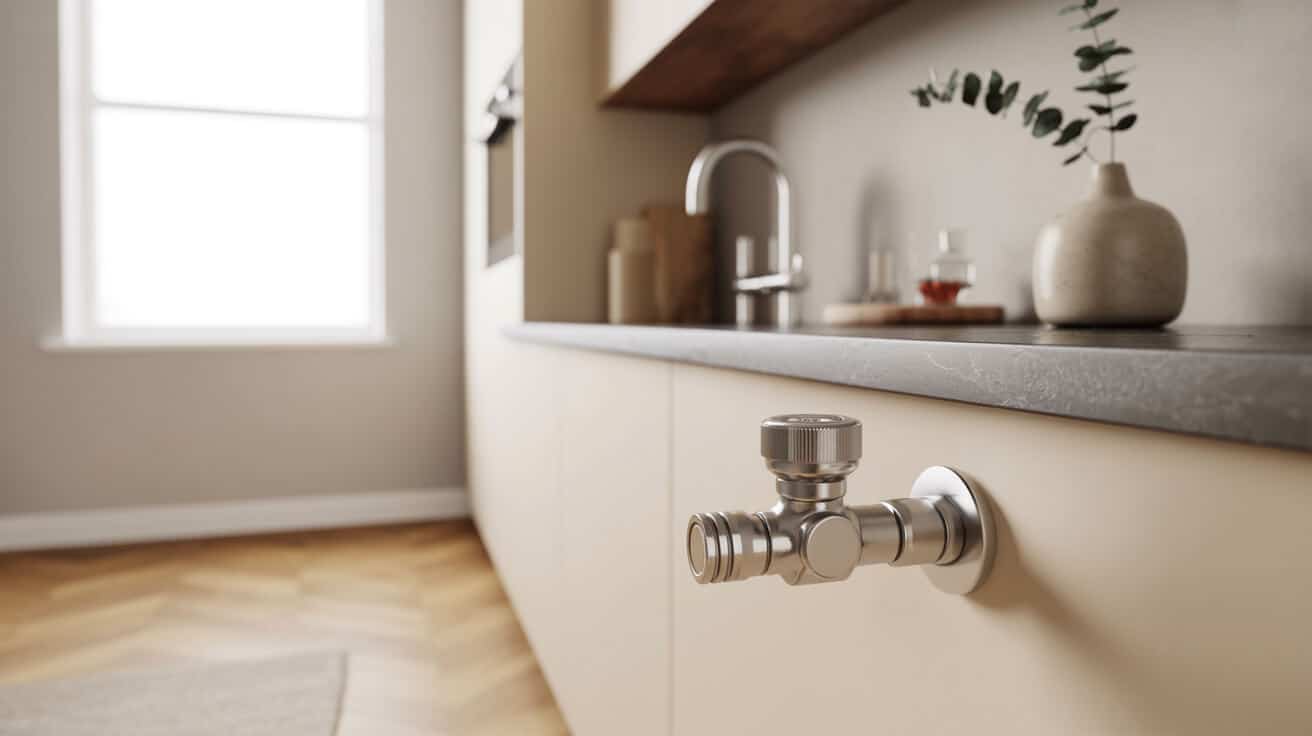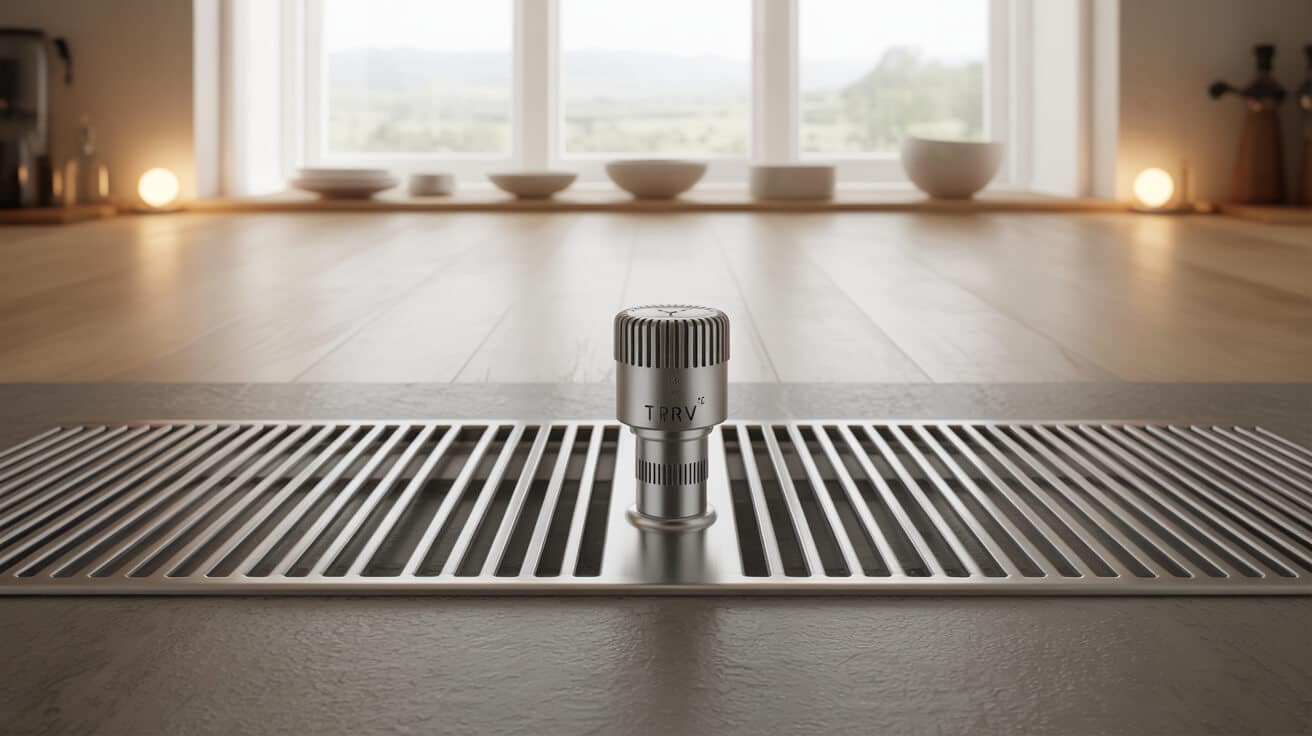Optimising energy use in space heating often begins at the point of control—where a room’s temperature is sensed and responded to directly. TRVs are foundational in this transition from monolithic heating approaches to adaptive, occupant-oriented management, especially as property owners and managers seek to enhance energy ratings, lower operational costs, and meet new legal obligations. Installation and calibration by experienced providers, including Plumbers 4U, are closely linked to performance outcomes and compliance with key regulatory benchmarks.
Etymology or name origin
The designation “thermostatic radiator valve” unites elements of temperature actuation (“thermostatic”), functional context (“radiator”), and operational mechanism (“valve”). “TRV” entered technical vocabulary as heating systems advanced beyond manual controls, reflecting the device’s emergence as a primary tool for automatic, room-level heat regulation.
Overview and context
TRVs are core components in water-based (hydronic) heating systems, enabling decoupling of the temperature in individual rooms from the broader thermal regime set by the central boiler. energy management policies in Europe and the UK specifically identify these controls as necessary for the transition to efficient, demand-responsive heating. The real-world context for TRV deployment includes detached houses, flats, multi-tenant developments, public buildings, and nearly all commercial properties where localised heating is either required by regulation or preferred for operational reasons.
Heating professionals, such as those at Plumbers 4U, undertake feasibility assessments, product selection, and balanced installation for a wide spectrum of clients—from families seeking greater control over their monthly energy spend, to asset managers charged with decarbonizing entire portfolios. These services are delivered against a backdrop of continuously tightening standards and rapidly evolving technical possibilities, especially in retrofitting older systems to meet contemporary expectations.
Role in heating system design
Each hydronic radiator fitted with a TRV operates as a responsive node within the wider network, compensating for variations in occupancy, insulation, solar gain, and user preference. Unlike legacy configurations—where all radiators receive full flow whenever the central thermostat calls for heat—the network under TRV control becomes both adaptive and self-balancing.
Zoning and demand-driven operation
Thermal zoning means dividing a property into temperature-controlled areas on the basis of use, orientation, or user behaviour. TRVs are crucial enablers of this philosophy, ensuring that heating is only provided where and when it is desired.
Energy policy alignment
Governmental initiatives—including the UK’s Clean Growth Strategy—mandate or incentivize the use of room-by-room controls. EPC (Energy Performance Certificate) schemes assign tangible value to such measures, affecting both the attractiveness and legal compliance of properties in the market.
Building and usage diversity
In both new construction and building upgrades, TRVs offer affordable, scale-agnostic, and reliable solutions across owner-occupied, tenanted, commercial, and institutional settings.
History
Origins and early regulation
Research into steam and hot water heating during the 19th and early 20th centuries established the need for more granular heat control than was available through manual valves or simple thermostats. The first iterations of TRVs emerged alongside the advent of closed, pressurised hydronic networks, with wax or liquid capsules providing the sensory input to adjust valve position in response to temperature.
Mass adoption and industrialization
The energy crises of the 1970s and 1980s highlighted inefficiencies in blanket heating strategies, accelerating standardisation. New regulatory frameworks began to require local controls in all major renovations and new builds. Mechanical TRVs became a default technology, with installation best practices codified in manufacturer documentation and industry training.
Recent advancements and regulatory drivers
Electronic and programmable TRVs appeared as microcontroller technology became cost-effective. Regulatory pressure—especially from UK Building Regulations Part L, Boiler Plus, and emerging European Union Directives—ensured that room-level zoning moved from an energy-saving option to a routine legal requirement. The role of technology service firms, including Plumbers 4U, expanded rapidly, matching innovation with compliance resources.
Contemporary innovation
Recent progress has seen TRVs integrated into broader building controls via wireless, programmable, and app-controlled systems, enabling central statistical optimization even in older buildings. Compatibility enhancements, tamper-resistant designs, and modular variants reflect growing demand from landlords and public sector managers handling vulnerable or high-turnover populations.

Concept and description
TRVs consist of a sensor head (detecting air temperature), a valve body (installed in-line with a radiator’s flow or return), an actuator (opening/closing the passage), and—on programmable or smart models—an electronic interface for schedules and adjustment.
Components and operation
Most mechanical TRVs house a wax or liquid-filled capsule within the head; as temperature rises, material expansion pushes a pin connected to the valve seat, restricting water flow. When the ambient temperature drops, the material contracts, reopening the valve pathway for circulation.
Feedback and automatic modulation
TRVs enact a feedback loop. Each room’s actual air temperature is continuously compared to the selected set-point; the valve automatically modulates between open and closed, achieving stable comfort with minimal energy input.
Installation and zoning
Fitting usually occurs at the radiator entry, though systems may require specific configuration to ensure one radiator—often in a hallway or near a room thermostat—remains unregulated to prevent short-cycling or pressure spikes.
Manual valve comparison
Unlike manual valves, which require intervention to match seasonal demands or adapt for day/night temperature shifts, TRVs offer persistent, granular control without ongoing user oversight.
Functionality, purpose, and applications
TRVs serve as decentralised intelligence nodes in the heating system, providing both static and dynamic optimization of comfort and efficiency.
Immediate applications
- Maintaining distinct comfort zones—such as cooler bedrooms, warmer lounges, and unheated spare rooms.
- Suppressing heat in rarely used rooms while supporting quick recovery when occupancy resumes.
Energy and cost reduction
The reduction in overheating (where radiators provide more heat than necessary) directly yields measurable energy savings. Field studies describe 8–18% reduction in heating fuel usage vs. systems without room-level controls, with variation by climate, building fabric, and occupant behaviour.
Regulatory and compliance impacts
TRVs materially improve asset compliance with MEES, increase EPC grades above statutory minimums, and are increasingly factored into financial modelling for landlords and large property portfolios.
Comfort and occupant wellbeing
Residents in TRV-controlled buildings report fewer thermal complaints, more even temperatures, and—due to reduced over-drying of air—a lower incidence of comfort-related health problems.
Application spectrum
TRVs are fitted in:
- Individual owner-occupied homes (for personalised heating control).
- Multi-unit residential rentals (for compliance and tenant comfort).
- Hotels, schools, office buildings (where differentiated thermal needs and cost centres exist).
- Hybrid heating and renewable installations seeking to optimise secondary or zone-specific heat sources.
Classifications and variants
Mechanical TRVs
Found in the majority of existing homes, mechanical TRVs rely on wax or liquid cartridge sensors for actuation. Their primary advantages are reliability, cost-effectiveness, and independence from user interaction once set.
Electronic and programmable models
electronic TRVs replace conventional heads with digital sensors and actuators, often featuring LED or LCD displays, buttons for local programming, and the ability to set multiple temperature schedules according to occupancy or usage patterns.
Smart and app-enabled models
Wireless connectivity allows for schedule adjustment, real-time monitoring, and scenario-based automation, empowering users and facility managers to query, override, or optimise heating at any time. Some models interface with third-party scheduling aids, occupancy detection, or building management analytics.
Commercial, tamper-proof, and specialist TRVs
Applications in social or multi-tenant housing, schools, and public spaces often demand devices with lockable or tamper-resistant heads, pre-set maximum and minimum temperature limits, and fail-safe design to prevent sabotage or accidental misuse.
Standards and compliance
BS EN 215 governs essential tests and performance criteria for TRVs in Europe, setting the legal and insurance benchmarks for British and European property managers. Major manufacturers (Danfoss, Drayton, Honeywell, among others) adhere to these standards, making specification and replacement straightforward across diverse system brands.
Installation practices and process
Assessment and planning
- Evaluate radiator compatibility (thread pitch, pipe orientation).
- Survey for physical access, clearance, and potential for obstruction by furniture or curtains.
- Confirm that at least one radiator in the property will remain unregulated to act as a bypass if the boiler or system is not fitted with a dedicated bypass circuit.
Preparation and safety
- Isolate water flow via valves or system drain-down.
- Protect flooring and adjacent surfaces from water release or debris.
- Confirm all tools are on hand: spanners, PTFE tape, alignment guides, pressure testers.
Stepwise fitting
- Remove old valve assembly and prepare threads.
- Wrap new threads with PTFE tape or apply manufacturer-recommended sealant.
- Position and tighten TRV body, align flow/return as specified.
- Attach head, set initial temperature setting.
- Slowly refill system, bleed radiators thoroughly, and check for leaks.
Calibration and balancing
- Adjust lockshield valves to ensure balanced heat output across sequential radiators.
- Test responsiveness of TRV head at different settings and environmental conditions.
User orientation and maintenance
- Demonstrate settings, explain how to respond to seasonal variation or unresponsive radiators.
- Note that periodic recalibration and, in the case of electronic models, battery or firmware checks may be required.
- Plumbers 4U includes a user-support orientation after every installation as part of standard service.

Tools, methodologies, and associated systems
Tools required
- Spanners, pliers, and specialist valve tools for installation or removal.
- Pipe cutters for adjustments in retrofits.
- PTFE tape or thread sealant to ensure integrity at connections.
- Pressure gauges, air bleed keys, and sometimes an endoscope for system diagnostics.
Testing and commissioning
- Leak and pressure testing for overall system health.
- Use of temperature probes for verifying TRV set-point accuracy and system balance.
- Automated systems may require app pairing or manual override demonstration.
System compatibility considerations
- Validation of one-pipe vs. two-pipe system compatibility.
- Assessment of heating circuit configuration (S-plan, Y-plan, etc.) to avoid flow issues or bypass errors.
Best practices
- Always instal according to manufacturer and regulatory best practice to ensure warranty and safety.
- Plumbers 4U service protocols reflect the latest standards and frequently incorporate brand-specific training for new product features.
Stakeholders and entities involved
Homeowners and occupants
- Direct users of comfort and cost benefits.
- Able to enhance property valuation and EPC ratings through investment in modern controls.
Landlords and managing agents
- Responsible for legal compliance, tenant satisfaction, and maintenance documentation.
- Discouraged from disabling or misusing controls through regulatory pressure and regular inspections.
Commercial and institutional property managers
- Oversee installation, scheduling, and maintenance at scale for offices, schools, hospitality, and retail environments.
- Rely on robust controls and anti-tamper features to minimise misuse in multi-user settings.
Plumbing and heating engineers
- Select, instal, calibrate, and service TRVs according to system demands and regulatory requirements.
- Must remain up to date with evolving technical standards, regulatory frameworks, and product innovations. Plumbers 4U maintains ongoing professional development for all engineers.
Certifying organisations and consultancy bodies
- The Chartered Institute of Plumbing and Heating Engineering (CIPHE), Gas Safe Register, WRAS, and the Energy Saving Trust set technical benchmarks, certify skills, and disseminate compliance advice.
Legal, regulatory, and ethical considerations
Regulatory frameworks
- The UK’s Part L of the Building Regulations requires effective room-by-room heating control in all new and many retrofitted buildings, making TRV installation either mandatory or heavily incentivized.
- Boiler Plus standards reinforce this requirement, particularly in relation to energy efficiency enhancements and system controls.
Performance and installation standards
- BS EN 215 covers the manufacture, testing, and recommended use of TRVs. Proper adherence to these specifications is essential for compliance with law, warranty claims, and insurance.
- Asset registers and documentation must record TRV types, locations, and calibration dates.
Obligations for landlords and property managers
- Minimum Energy Efficiency Standards regulations, relevant for all rented dwellings, require that zoning controls such as TRVs are both present and functioning as specified.
- Many local grants, such as ECO4 and BUS, are only available if installation and documentation meet the latest guidance.
- Installing TRVs with anti-tamper heads in rental and social housing settings protects vulnerable tenants from manipulations that could lead to unintended energy cost increases. Maintenance and calibration must also ensure all users enjoy a safe, cost-effective heating environment—especially those unable to make changes themselves.
Performance metrics, data, and empirical studies
| Metric | Control Properties | Typical Value / Range | Source Type |
|---|---|---|---|
| Energy saving (heating) | Mechanical TRV | 8–18% reduction in kWh | Field studies, audits |
| Room comfort variance | TRV-controlled | ±1.5°C of set point | Manufacturer tests |
| Complaint reduction | Multi-zone TRV | Up to 40% fewer heating complaints | Asset manager reports |
| Economic payback period | Standard instal | 2–4 years | Utility case studies |
| EPC improvement | Retrofit upgrade | 5–10 points, occasionally more | Government modelling |
Impact on mortgage, asset, and let-ability
Efficient heating controls, including TRVs, now factor heavily in property surveys. This can shape mortgage qualification, rental status, and ongoing asset value for owners and developers.
Case studies
- Public sector retrofit schemes routinely document above-average energy savings from TRV upgrades.
- Controlled university studies verify direct links between TRV use, system balancing, and reductions in carbon emissions per floor area.
Challenges, barriers, and limitations
Technical and operational
- Installation in legacy or single-pipe radiator systems may require modifications or alternative controls, occasionally escalating cost and complexity.
- Manual override, tampering, or customer misunderstanding may reduce anticipated benefits. Regular inspection and customer guidance are essential.
Economic
- Upfront cost, though modest compared to boiler upgrades, still represents a barrier for some owners. Inconsistent local awareness of funding programmes can slow uptake in high-need areas.
Social and behavioural
- Mistrust of “automated” controls can lead some users to set all TRVs to maximum, undermining zone management.
- Households with variable occupancy patterns may require more frequent adjustment or more advanced adaptive control solutions.
Maintenance
- Batteries in electronic models require periodic replacement, and heads in high-traffic areas may be prone to damage or dirt ingress.
Sector-specific obstacles
- Rental and low-income sectors may experience delayed or partial upgrades due to budgetary, legal, or organisational challenges.
- Plumbers 4U regularly partners with housing authorities to address inequality in access to heating efficiency measures.
Impact, influence, and legacy
Decarbonization and climate progress
TRVs make measurable, persistent contributions to national and European decarbonization and heating efficiency targets. They are credited with supporting long-term reduction in fossil fuel use and carbon emissions from domestic space heating.
Building market and regulatory transformation
Near-universal specification of TRVs in new-build housing reflects their status as a building block for all best-practice heating specification. Regular updates to guidance and regulatory standards now treat room-based controls as essential, not optional.
Professional standards and sector knowledge
Professional bodies include TRV installation, troubleshooting, and calibration as integral to certification and ongoing training. Firms like Plumbers 4U incorporate these elements in quality assurance and service documentation for every contract.
Cultural and user perception
The capacity for individual room control, previously considered a premium feature, is now expected as a baseline in all property sectors, contributing to changing norms around user comfort and control.
Future directions, cultural relevance, and design discourse
Smart, adaptive, and user-centred innovation
The fastest-growing segment engages user habits through adaptive scheduling, learning algorithms, and improved interface ergonomics. Emerging standards will likely require greater reporting and feedback for both users and asset managers.
Design and accessibility
A move toward accessible, visually appealing controls is lowering psychological and practical barriers to TRV engagement, especially for those with limited mobility or digital literacy.
Policy trajectory
Ongoing consultation suggests that further tightening of heating control regulations, as well as expansion of grant eligibility, will reinforce the necessity for robust, user-facing controls.
Ongoing research, debate, and critique
Studies continue to refine the evidence base for TRV effectiveness, with ongoing exploration into limitations in certain system types, the need for correct installation, and user engagement as key determinants of realised savings.
Social integration, public messaging, sector leadership
As “smart home” and “net zero” concepts move into mainstream discourse, TRVs—both mechanical and smart—are projected to become the standard by which building heating efficiency is measured, supported by professional best practices and ongoing innovation from leading service providers, including Plumbers 4U.

